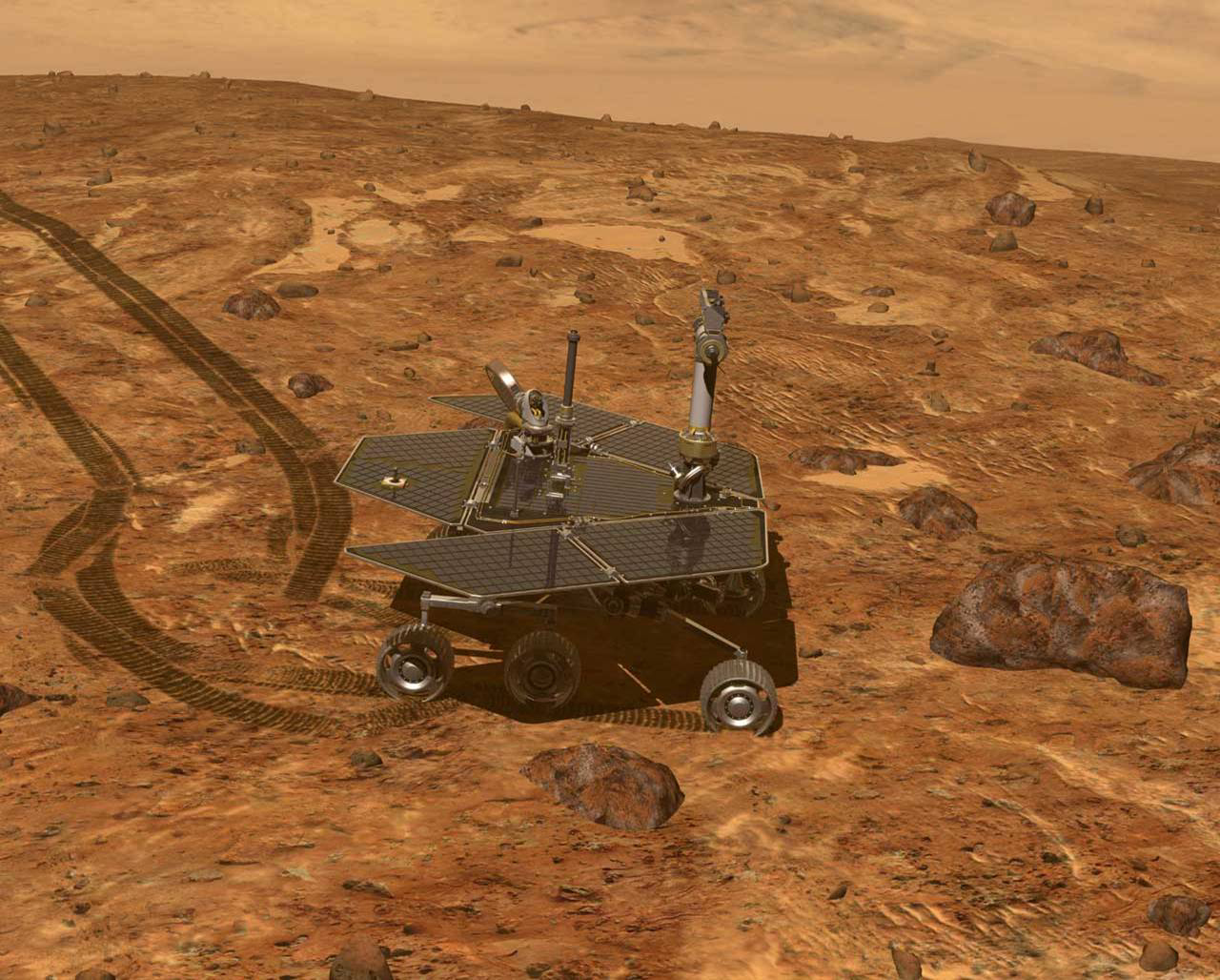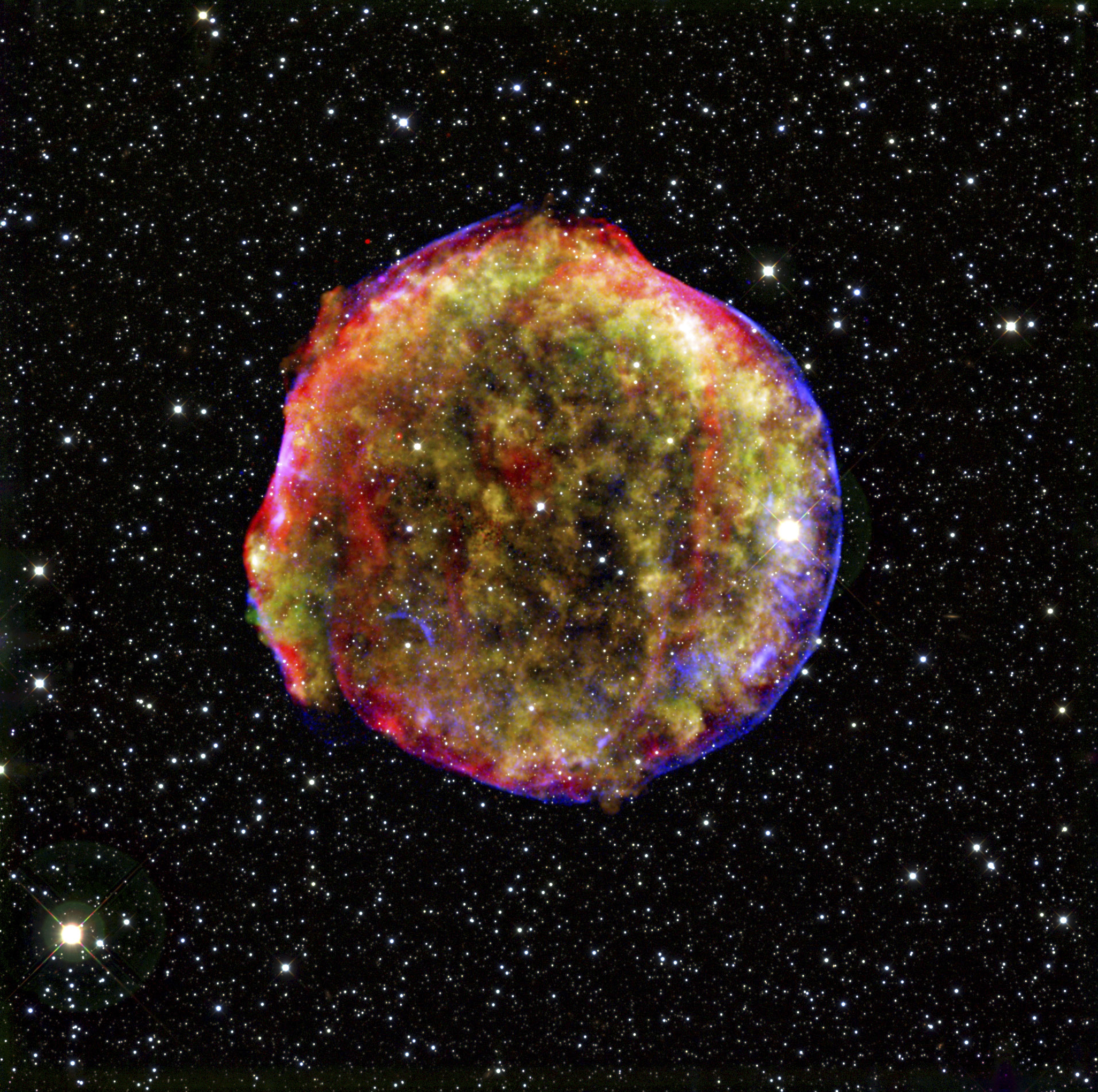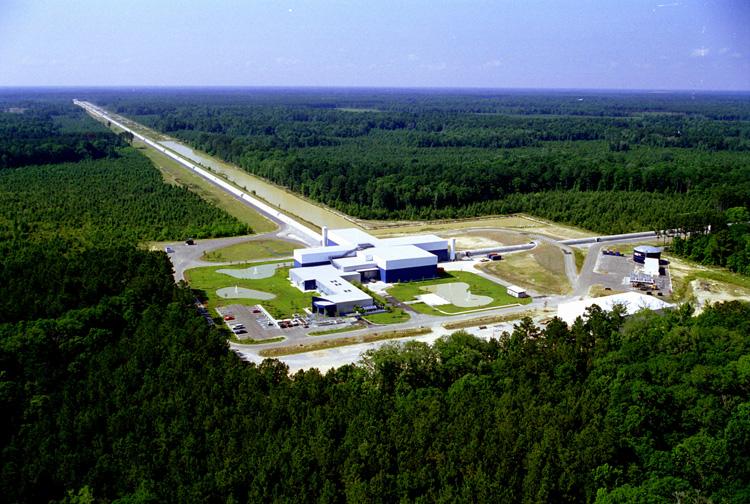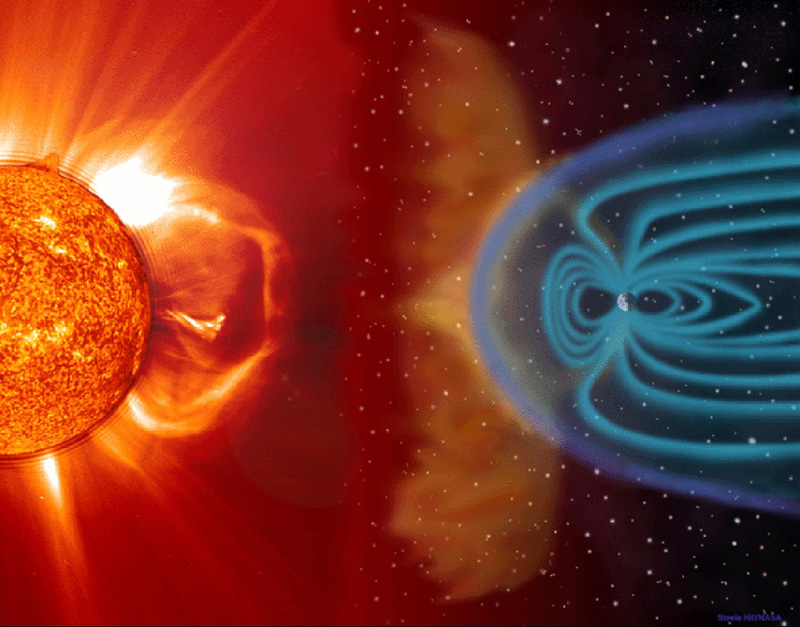Next Launch
Total Students
2,609
Total Launches
683
Eggs Survived
418 61.2%
Rockets Survived
536 78.5%
April 1, 2010
A Rock Hound is Born
by Staff
It's tough to be a geologist when you can't tell one rock from another. Is that a meteorite or a chunk of lava? A river rock or an impact fragment? Houston, we have a problem!
It's a problem Spirit and Opportunity have been dealing with for the past six years. The two rovers are on a mission to explore the geology of the Red Planet, yet for the longest time they couldn't recognize interesting rocks without help from humans back on Earth.
Fortunately, it is possible to teach old rovers new tricks. All you have to do is change their programming--and that's just what NASA has done.
"During the winter, we uploaded new software to Opportunity," says Tara Estlin, a rover driver, senior member of JPL's Artificial Intelligence Group, and the lead developer of AEGIS, short for Autonomous Exploration for Gathering Increased Science. "AEGIS allows the rover to make some decisions on its own."
Estlin and her team have been working for several years to develop and upload increasingly sophisticated software to the rovers. As a result, the twins have learned to avoid obstacles, identify dust devils, and calculate the distance to reach their arms to a rock.
With the latest upgrade, a rock hound is born.
Now, Opportunity's computer can examine images that the rover takes using its wide-angle navigation camera (NavCam) and pick out rocks with interesting colors or shapes. It can then center its narrower-angle panoramic camera (PanCam) on targets of interest for close-up shots through various color filters. All this happens without human intervention.
The system was recently put to the test; Opportunity performed splendidly.
At the end of a drive on March 4th, the rover settled in for a bit of rock hunting. Opportunity surveyed the landscape and decided that one particular rock, out of more than 50 in the NavCam photo, best met criteria that researchers had set for a target of interest: large and dark.
"It found exactly the target we would want it to find," Estlin says. "It appears to be one of the rocks tossed outward onto the surface when an impact dug a nearby crater." The new software doesn't make humans obsolete. On the contrary, humans are very much "in the loop," setting criteria for what's interesting and evaluating Opportunity's discoveries. The main effect of the new software is to strengthen the rover-human partnership and boost their combined exploring prowess.
Mindful that Opportunity was only supposed to last about six months after it landed in 2004, Estlin says "it is amazing to see Opportunity performing a brand new autonomous activity six years later."
What will the rock hounds of Mars be up to six years from now? Stay tuned for future uploads!
Learn more about how the AEGIS software works at https://scienceandtechnology.jpl.nasa.gov/under-their-own-aegis. If you work with middle- or high-school kids, you'll find a fun way to explore another kind of robot software--the kind that enables "fuzzy thinking"--at http://spaceplace.nasa.gov/en/educators/teachers_page2.shtml#fuzzy.
This article was provided by the Jet Propulsion Laboratory, California Institute of Technology, under a contract with the National Aeronautics and Space Administration.
 Opportunity spots a rock with its NavCam that its AEGIS software says meets all the criteria for further investigation.
Opportunity spots a rock with its NavCam that its AEGIS software says meets all the criteria for further investigation.
May 1, 2010
Ancient Supernova Riddle, Solved
by Dr. Tony Phillips
Australopithecus squinted at the blue African sky. He had never seen a star in broad daylight before, but he could see one today. Was it dangerous? He stared for a long time, puzzled, but nothing happened, and after a while he strode across the savanna unconcerned.
Millions of years later, we know better.
That star was a supernova, one of many that exploded in our corner of the Milky Way around the Pliocene era of pre-humans. Australopithecus left no records; we know the explosions happened because their debris is still around. The Solar System and everything else within about 300 light-years is surrounded by supernova exhaust—a haze of million-degree gas that permeates all of local space.
Supernovas are dangerous things, and when one appears in the daytime sky, it is cause for alarm. How did Earth survive? Modern astronomers believe the blasts were too far away (albeit not by much) to zap our planet with lethal amounts of radiation. Also, the sun’s magnetic field has done a good job holding the hot gas at bay. In other words, we lucked out.
The debris from those old explosions has the compelling power of a train wreck; astronomers have trouble tearing their eyes away. Over the years, they’ve thoroughly surveyed the wreckage and therein found a mystery--clouds of hydrogen and helium apparently too fragile to have survived the blasts. One of them, whimsically called “the Local Fluff,” is on the doorstep of the Solar System.
“The observed temperature and density of the Fluff do not provide enough pressure to resist the crushing action of the hot supernova gas around it,” says astronomer Merav Opher of George Mason University. “It makes us wonder, how can such a cloud exist?
NASA’s Voyager spacecraft may have found the answer.
NASA's two Voyager probes have been racing out of the solar system for more than 30 years. They are now beyond the orbit of Pluto and on the verge of entering interstellar space. "The Voyagers are not actually inside the Local Fluff," explains Opher. "But they are getting close and can sense what the cloud is like as they approach it."
And the answer is….
“Magnetism,” says Opher. "Voyager data show that the Fluff is strongly magnetized with a field strength between 4 and 5 microgauss. This magnetic field can provide the pressure required to resist destruction."
If fluffy clouds of hydrogen can survive a supernova blast, maybe it’s not so surprising that we did, too. “Indeed, this is helping us understand how supernovas interact with their environment—and how destructive the blasts actually are,” says Opher.
Maybe Australopithecus was on to something after all.
Opher’s original research describing Voyager’s discovery of the magnetic field in the Local Fluff may be found in Nature, 462, 1036-1038 (24 December 2009). The Space Place has a new Amazing Fact page about the Voyagers’ Golden, with sample images and sounds of Earth. After all, just in case one of the Voyager’s ever meets up with ET, we will want to introduce ourselves. Visit http://spaceplace.nasa.gov/en/kids/voyager.
This article was provided by the Jet Propulsion Laboratory, California Institute of Technology, under a contract with the National Aeronautics and Space Administration.
 Left-over cloud from the Tycho supernova, witnessed by Tycho Brahe and other astronomers over 400 years ago. This image combines infrared light captured by the Spitzer Space Telescope with x-rays captured by the Chandra X-ray Observatory, plus visible light from the Calar Also Observatory in Spain.
Left-over cloud from the Tycho supernova, witnessed by Tycho Brahe and other astronomers over 400 years ago. This image combines infrared light captured by the Spitzer Space Telescope with x-rays captured by the Chandra X-ray Observatory, plus visible light from the Calar Also Observatory in Spain.
June 1, 2010
Black Holes No Joke
by Dr. Tony Phillips
Kip Thorne: Why was the black hole hungry?
Stephen Hawking: It had a light breakfast!
Black hole humor—you gotta love it. Unless you’re an astronomer, that is. Black holes are among the most mysterious and influential objects in the cosmos, yet astronomers cannot see into them, frustrating their attempts to make progress in fields ranging from extreme gravity to cosmic evolution.
How do you observe an object that eats light for breakfast?
“Black holes are creatures of gravity,” says physicist Marco Cavaglia of the University of Mississippi. “So we have to use gravitational waves to explore them.”
Enter LIGO—the NSF-funded Laser Interferometer Gravitational-wave Observatory. According to Einstein’s Theory of General Relativity, black holes and other massive objects can emit gravitational waves—ripples in the fabric of space-time that travel through the cosmos. LIGO was founded in the 1990s with stations in Washington state and Louisiana to detect these waves as they pass by Earth.
“The principle is simple,” says Cavaglia, a member of the LIGO team. “Each LIGO detector is an L-shaped ultra-high vacuum system with arms four kilometers long. We use lasers to precisely measure changes in the length of the arms, which stretch or contract when a gravitational wave passes by.”
Just one problem: Gravitational waves are so weak, they change the length of each detector by just 0.001 times the width of a proton! “It is a difficult measurement,” allows Cavaglia.
Seismic activity, thunderstorms, ocean waves, even a truck driving by the observatory can overwhelm the effect of a genuine gravitational wave. Figuring out how to isolate LIGO from so much terrestrial noise has been a major undertaking, but after years of work the LIGO team has done it. Since 2006, LIGO has been ready to detect gravitational waves coming from spinning black holes, supernovas, and colliding neutron stars anywhere within about 30 million light years of Earth.
So far the results are … nil. Researchers working at dozens of collaborating institutions have yet to report a definite detection.
Does this mean Einstein was wrong? Cavaglia doesn’t think so. “Einstein was probably right, as usual,” he says. “We just need more sensitivity. Right now LIGO can only detect events in our little corner of the Universe. To succeed, LIGO needs to expand its range.”So, later this year LIGO will be shut down so researchers can begin work on Advanced LIGO—a next generation detector 10 times more sensitive than its predecessor. “We’ll be monitoring a volume of space a thousand times greater than before,” says Cavaglia. “This will transform LIGO into a real observational tool.”
When Advanced LIGO is completed in 2014 or so, the inner workings of black holes could finally be revealed. The punchline may yet make astronomers smile.
Find out more about LIGO at http://www.ligo.caltech.edu/. The Space Place has a LIGO explanation for kids (of all ages) at http://spaceplace.nasa.gov/en/kids/ligo, where you can “hear” a star and a black hole colliding!This article was provided by the Jet Propulsion Laboratory, California Institute of Technology, under a contract with the National Aeronautics and Space Administration.
 Laser Interferometer Gravitational-wave Observatory in Livingston, Louisiana. Each of the two arms is 4 kilometers long. LIGO has another such observatory in Hanford, Washington.
Laser Interferometer Gravitational-wave Observatory in Livingston, Louisiana. Each of the two arms is 4 kilometers long. LIGO has another such observatory in Hanford, Washington.
July 1, 2010
The Sun is Still Boss
by Dr. Tony Phillips
Grab your cell phone and take a good long look. It's indispensible, right? It tells time, surfs the web, keeps track of your appointments and, by the way, also makes phone calls. Modern people can hardly live without one.
One good solar flare could knock it all out.
“In the 21st century, we’re increasingly dependent on technology,” points out Tom Bogdan, director of NOAA's Space Weather Prediction Center in Boulder, Colorado. “This makes solar activity an important part of our daily lives.”
Indeed, bad space weather can knock out power systems, telecommunications, financial and emergency services—basically, anything that needs electronics to work. That’s why NOAA is building a new fleet of “space weather stations,” the GOES-R satellites.
“GOES-R will bring our existing fleet of weather satellites into the 21st century,” says Bogdan. “They're designed to monitor not only Earth weather, but space weather as well.”
NOAA's existing fleet of Geostationary Operational Environmental Satellites (GOES) already includes some space weather capabilities: solar ultraviolet and X-ray telescopes, a magnetometer and energetic particle sensors. GOES-R will improve upon these instruments and add important new sensors to the mix.
One of Bogdan’s favorites is a particle detector named “MPS-Low,” which specializes in sensing low-energy (30 ev – 30 keV) particles from the sun.
Who cares about low-energy particles? It turns out they can be as troublesome as their high-energy counterparts. Protons and other atomic nuclei accelerated to the highest energies by solar flares can penetrate a satellite’s exterior surface, causing all kinds of problems when they reach internal electronics. Low-energy particles, particularly electrons, can’t penetrate so deeply. Instead, they do their damage on the outside.
As Bogdan explains, “Low-energy particles can build up on the surfaces of spacecraft, creating a mist of charge. As voltages increase, sparks and arcs can zap electronics—or emit radio pulses that can be misinterpreted by onboard computers as a command.”
The Galaxy 15 communications satellite stopped working during a solar wind storm in April 2010, and many researchers believe low-energy particles are to blame. GOES-R will be able to monitor this population of particles and alert operators when it’s time to shut down sensitive systems. “This is something new GOES-R will do for us,” says Bogdan.
The GOES-R magnetometer is also a step ahead. It will sample our planet’s magnetic field four times faster than its predecessors, sensing vibrations that previous GOES satellites might have missed. Among other things, this will help forecasters anticipate the buildup of geomagnetic storms.
And then there are the pictures. GOES–R will beam back striking images of the sun at X-ray and extreme UV wavelengths. These are parts of the electromagnetic spectrum where solar flares and other eruptions make themselves known with bright flashes of high-energy radiation. GOES-R will pinpoint the flashes and identify their sources, allowing forecasters to quickly assess whether or not Earth is in the “line of fire.”
They might also be able to answer the question, Is my cell phone about to stop working?
The first GOES-R satellite is scheduled for launch in 2015. Check www.goes-r.gov for updates. Space weather comes down to Earth in the clear and fun explanation for young people on SciJinks, http://scijinks.gov/space-weather-and-us.
This article was provided by the Jet Propulsion Laboratory, California Institute of Technology, under a contract with the National Aeronautics and Space Administration.
 In spite of Earth’s protective magnetosphere, solar storms can wreak havoc with Earth satellites and other expensive electronics on the ground.
In spite of Earth’s protective magnetosphere, solar storms can wreak havoc with Earth satellites and other expensive electronics on the ground.